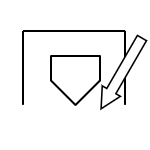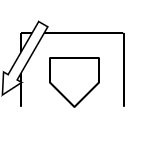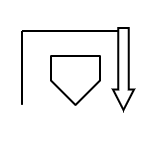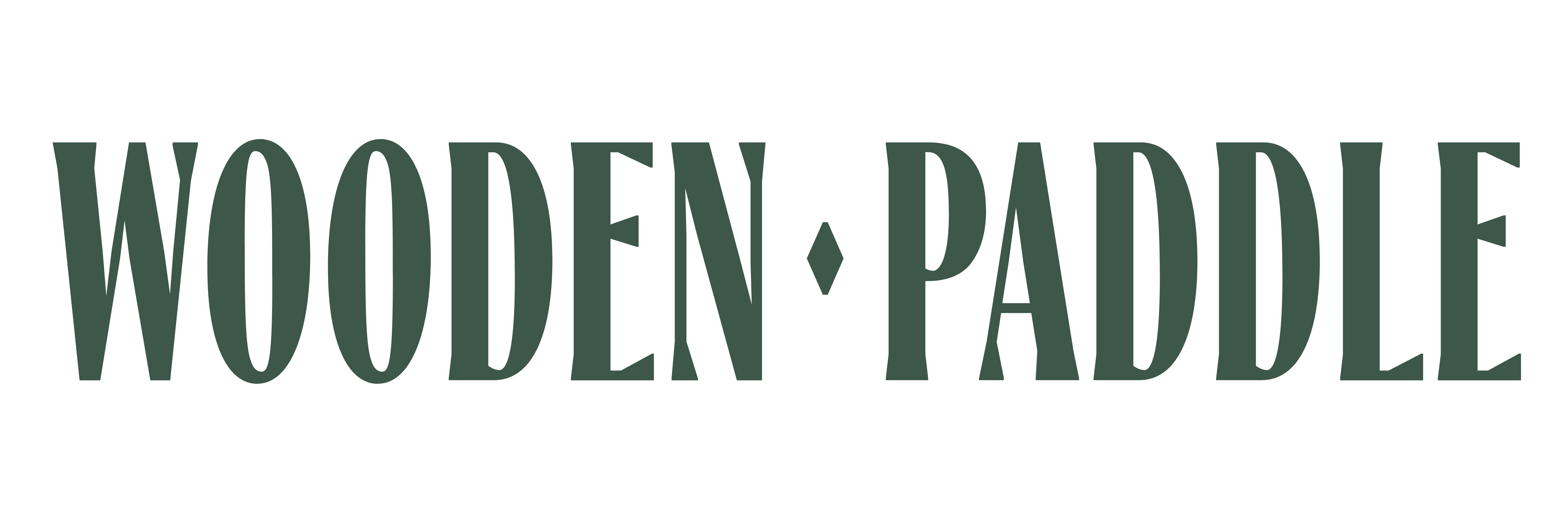OFFICIAL RULES
Last modified: May 21, 2024
Changes from previous version highlighted in yellow
THE BASICS
GENERAL
- If a team leads by ten (10) runs or more after five (5) innings (4-1⁄2 if the home team leads), the game will be declared over by 'mercy rule'.
DEFENSE
- Teams can place between a minimum of eight (8) players and a maximum of ten (10) players on the field. At least four (4) women must be on the field at all times.
- One of the team players must be catcher. Otherwise, there are no restrictions on fielder positioning.
- No fielder may step fully across the 1st-3rd base diagonal until the ball is kicked.
- No fielders may tag the safety base while making a play at first base, except on an overthrow.
- All pitches must be thrown underhand only. Sidearm pitching is not allowed.
- In "B" and "C" level games, a pitch that spins is an illegal pitch and, if not kicked, is a ball. This includes side-spin and back-spin. The kicker does have the option of kicking the pitch if he/she so chooses, but must take the result of that play if he/she does.
- If a pitch bounces higher than 1 foot off the ground (as measured from the bottom of the kickball) at any time while passing through the strike zone, it is a ball. The kicker does have the option of kicking the pitch if he/she so chooses, but must take the result of that play if he/she does.
- A pitch that bounces less than two times before entering the strike zone is a ball. A pitch rolled directly along the ground is considered to have bounced at least twice.
OFFENSE
- The count begins at one (1) ball and one (1) strike.
- All players must kick but no more than 2 men can kick in succession, even when going from the end to the beginning of the kicking order.
- All kicks must be made by the foot (below the knee).
- All kicks must be taken behind the front edge of home plate. In "A" and "B" level games, kicks must also be taken in front of the back line. Positioning is determined by the front of the plant foot.
- Men must kick the ball past the 1st-3rd base diagonal. Women must kick the ball past the female bunt line marked 10 feet from the plate. The ball must come to stop in contact with the line or beyond the line to be fair.
- If the ball is fielded before it reaches this diagonal, it is considered a fair ball.
- A kicker attempting to run through first base when a play is being made must tag the safety base, not first base, except on an overthrow. A kicker tagging first base (or the safety base on an overthrow) when running through the base from home plate is out, unless no play is being made.
- Neither leading off base nor stealing a base is allowed.
- A runner hit with the ball above shoulder level is safe and advances one (1) base except when:
- Runners may leave base as soon as a fly ball is touched by a member of the fielding team. If a kicked ball is caught in foul territory (for an out), runners may advance after tagging up. (See ASA softball rules for further clarification if needed.)
- Pinch runners are only allowed in cases of injury.
- All foul balls count as strikes, even on the third strike.
- A runner touched by the ball at any time while not on base, except when that runner has passed first base with no intent to advance to second base (the ball remains live in this exception);
THE DETAILS
FIELD
- The kickball diamond is a square with bases at each corner and equal sides of 60 feet making the base lines.
- The distance from home plate to 2nd base and from 1st base to 3rd base is 84 feet 10 1/4 inches. The 1st-3rd base diagonal is marked with a dashed line.
- The center of the pitcher's strip is in the center of the diamond, 42 feet 5 1/8 inches from home plate and directly aligned with the 1st-3rd base diagonal. There is a 'pitcher's box' behind the pitcher's strip that measures 9 feet wide by 9 feet deep.
- The strike zone extends 1 foot to either side and in front of home plate and is 1 foot high. There is an incomplete box marked around home plate (back side is omitted) which designates the 'strike zone'.
- The back line is marked 8 feet behind the front edge of home plate.
- The center of the 'female bunt line' is 10 feet from the front edge of home plate and is parallel to the 1st-3rd base diagonal.
- There is an extra 'safety base' 1 foot directly to the right of first base in foul territory.
TEAMS
- All players must be at least 18 years of age and wear their official league-issued shirts to play in a game and receive the drink specials at the sponsor bar afterwards. KLOC shirts must be worn on top of any jackets or sweatshirts.
- Teams may challenge an opposing player's eligibility by requesting a team roster check to the umpire and/or league staff.
- If the opposing player is deemed to be eligible, the team may not challenge any player's eligibility again for the duration of the game.
- If the opposing player is deemed to be ineligible, the player must be immediately removed from the game. If the player has already kicked or has made a play in the field, the opposing team forfeits the game.
- All players must have signed their official KLOC team waiver form before the start of the season.
- Only players who are paid league members may play in a game. Players must play in at least one regular season game, regardless of any rainouts or forfeits, in order to play in the playoffs and/or tournament.
- KLOC reserves the right to conduct random roster checks throughout the season to verify player eligibility.
- Teams must have a minimum of fifteen (15) players on their roster. There is no maximum to the number of players that may be on a team's roster.
- Teams may add players to their roster after the season starts so long as they still meet all of the qualifications above. Teams may only change or remove players from their roster with approval of the commissioner responsible for their division and fees may apply.
- Teams with an outstanding balance will forfeit all games until their balance is paid in full.
GAMES
- Regular season games will last for seven (7) innings, with games being official after five (5) innings (4-1⁄2 if the home team leads). When game time has reached fifty (50) minutes, only one more full inning will be played (the game will be shortened if necessary).
- Unlike baseball, there are no extra innings in regular season games; the games can end in a tie. Tie-breakers are not permitted.
- Any team that is not ready to take the field at the scheduled kickoff time shall forfeit the game.
- Game Time is Forfeit Time. There is no grace period.
- There is a limit of nine (9) runs per inning in "A" and "B" level games, and six (6) runs per inning in "C" level games, except for the last inning.
- If a team leads by ten (10) runs or more after five (5) innings (4-1⁄2 if the home team leads), the game will be declared over by 'mercy rule'.
FIELDING
- Teams can place between a minimum of eight (8) players and a maximum of ten (10) players on the field. At least four (4) women must be on the field at all times.
- If a team has fewer than four (4) women present, they must play short and receive an automatic out when the missing woman's position is reached in the kicking order. If a team has fewer than ten (10) players present, but has at least 4 women, they do not receive any automatic outs.
- If a team has the minimum of eight (8) players, at least two (2) must be women (with automatic outs received for the other two women).
- One of the team players must be catcher. Otherwise, there are no restrictions on fielder positioning.
- A team may change fielders, so long as they maintain the minimum of four (4) women on the field, with one exception: the fielding team cannot change their catcher during an inning (except in cases of injury).
- No fielder may step fully across the 1st-3rd base diagonal until the ball is kicked.
- If any fielder makes an out by illegally advancing beyond the 1st-3rd base diagonal, the runner is safe.
- Fielders must stay out of the base line unless they are attempting to tag the runner or catch a kicked ball.
- Fielders trying to make a force out on a base may have their foot on the base, but must lean out of the base line.
- No fielders may tag the safety base while making a play at first base, except on an overthrow.
- If any fielder makes an out by illegally tagging the wrong base, the runner is safe.
- If a fielder physically obstructs a runner from advancing (or attempts to do so), the runner may advance as many bases as they would have potentially earned had they been able to run unobstructed. This is a judgment call by the umpire.
- The play is over when any member of the fielding team has the ball in control and is inside the pitcher's box or when all play has stopped. The umpire should call time and play will resume once the next pitch is thrown.
- There is no Infield Fly Rule. However, any player intentionally dropping a fly ball will be called for unsportsmanlike conduct, the ball is dead, and all runners are permitted to advance to the base to which they were running, but do not receive additional bases unless forced. This is a judgment call by the umpire.
- Teams can place between a minimum of eight (8) players and a maximum of ten (10) players on the field. At least four (4) women must be on the field at all times.
PITCHING/CATCHING
- The count begins at one (1) ball and one (1) strike.
- A pitch that passes through the strike zone while crossing or touching any line of the strike zone is a strike.
- A pitch that passes directly along one of the strike zone side lines is a strike.

Strike 
Strike 
Strike 
Strike - If the kicker attempts to kick a pitched ball, such that their kicking leg passes in front of their plant leg, but does not make contact with the ball, a strike will be called.
- A pitch that passes directly along one of the strike zone side lines is a strike.
- All pitches must be thrown underhand only. Sidearm pitching is not allowed.
- A pitch not thrown underhand is an illegal pitch and, if not kicked, is a ball. This is a judgment call by the umpire. The kicker does have the option of kicking the pitch if he/she so chooses, but must take the result of that play if he/she does.
- In "B" and "C" level games, a pitch that spins is an illegal pitch and, if not kicked, is a ball. This includes side-spin and back-spin. The kicker does have the option of kicking the pitch if he/she so chooses, but must take the result of that play if he/she does.
- In "A" level games, spinning pitches are allowed.
- In "C" level games, all pitches must be slow enough to allow kickers a good chance of kicking the ball. A pitch deemed too fast is an illegal pitch and, if not kicked, is a ball. This is a judgment call by the umpire.
- If a pitcher is called for an illegal pitch three times in the same game, that player may no longer pitch in the game. The player may still play other fielding positions.
- If a pitch bounces higher than 1 foot off the ground (as measured from the bottom of the kickball) at any time while passing through the strike zone, it is a ball. The kicker does have the option of kicking the pitch if he/she so chooses, but must take the result of that play if he/she does.
- A pitch that bounces less than two times before entering the strike zone is a ball. A pitch rolled directly along the ground is considered to have bounced at least twice.
- A pitch that stops before reaching the front edge of home plate is a ball.
- The pitcher must pitch from inside the pitcher's box and must stay inside the pitcher's box until the ball is kicked. If the pitcher steps fully outside of the pitcher's box, an illegal pitch (ball) will be called. The kicker has the option of kicking the pitch if he/she so chooses, but must take the result of that play if he/she does.
- The catcher must be positioned at least three (3) feet behind the kicker after the kicker has crossed the back line and until the ball is kicked. The catcher cannot obstruct the kicker.
- If the catcher obstructs the kicker, the kicker will receive first base. This is a judgment call by the umpire.
- If the catcher fails to catch an unkicked pitch, delay of game may be called by the umpire and one ball is added to the count. This is a judgment call by the umpire.
- On fields where a fence is not immediately present behind home plate, a player may serve as a "backstop" to help retrieve errant balls that have gone out of bounds. The player may be from either team and at all times should remain in the out of bounds area as determined by the umpire. The presence of this "backstop" player does not relieve the catcher of their duty to catch unkicked pitches or eliminate any penalties if the catcher fails to perform such duty.
- A pitch that intentionally hits a field cone is an illegal pitch. This is a judgment call by the umpire.
- In "C" level games, the pitcher or the catcher, or both, must be a female player.
KICKING
- All players must kick but no more than 2 men can kick in succession, even when going from the end to the beginning of the kicking order.
- If and only if there are more than twice as many men present as there are women, some women must re-kick, after the minimum of four women have kicked (or automatic outs have been received for missing women). However, women must remain in the same order of female kickers, even if this means continually changing their position in the overall kicking order.
- Any player who plays on the field but does not kick is considered an illegal player, except in cases of injury or extreme tardiness as noted in the rules that follow. The player will be permanently removed from the game and the offending team will receive an automatic out at the bottom of their kicking order for the remainder of the game.
- A team's kicking order cannot change after the first pitch. Players that arrive after the start of the game but before all other players on the kicking team have kicked once may be added to the bottom of the kicking order so long as there are still no more than 2 men kicking in succession (women must re-kick if necessary). Players that arrive after the start of the game and after all other players on the kicking team have already kicked once may only be used as substitutes for players of the same gender.
- If a team is playing short, a late arriving player may immediately enter the game and the bottom of the lineup. Gender requirements must still be met.
- The official kicking order must be provided to the umpire before the start of the game. The kicking team must keep an official scorecard.
- All kicks must be made by the foot (below the knee).
- All kicks must be taken behind the front edge of home plate. In "A" and "B" level games, kicks must also be taken in front of the back line. Positioning is determined by the front of the plant foot.
- If the ball is kicked in front of home plate, the kicker is out.
- In "A" and "B" level games, if the ball is kicked behind the back line, it is a foul and an illegal kick. If this foul ball is caught on the fly, the kicker is out. Once the ball is caught or touches the ground, play will be ruled dead and no runners may advance.
- Men must kick the ball past the 1st-3rd base diagonal. Women must kick the ball past the female bunt line marked 10 feet from the plate. The ball must come to stop in contact with the line or beyond the line to be fair.
- A kicked ball that comes to a stop behind this line is considered a foul ball.
- If the ball is fielded before it reaches this diagonal, it is considered a fair ball.
- If the ball is kicked by a male player and is fielded by any fielder other than the catcher before it crosses the female bunt line, it is a foul.
- If a kicker accidentally double-kicks the ball and the kicker's plant foot is still behind home plate, the kick is considered a foul ball. If a kicker accidentally double-kicks the ball and the kicker is in fair territory, the kicker is out. Kickers may not stop the ball with their foot and then kick it; if this type of double-kick occurs, the kicker is out.
- All players must kick but no more than 2 men can kick in succession, even when going from the end to the beginning of the kicking order.
RUNNING
- A runner's base path is established when a tag or throw attempt occurs and is a straight line from the runner to the base the runner is attempting to reach safely. If the runner travels more than three feet either way off their base path to avoid a tag or throw, the runner is out.
- A kicker attempting to run through first base when a play is being made must tag the safety base, not first base, except on an overthrow. A kicker tagging first base (or the safety base on an overthrow) when running through the base from home plate is out, unless no play is being made.
- A kicker who safely overruns first base may not be tagged out unless the kicker attempts to advance to second base. This is a judgment call by the umpire.
- A kicker tagging first base when running from home plate must avoid the first baseman. Failure to avoid the first baseman will result in the kicker being called out. This is a judgment call by the umpire.
- The fielder 'owns' the area inside the first base line and is free to make a play on a kicked ball within this area. If the runner interferes with the fielder inside the first base line, the runner is out.
- The runner 'owns' the area outside the first base line, including the safety base. If the fielder obstructs the runner's attempt to tag the safety base on his/her run to first, the runner is safe.
- On an overthrow to first base, this 'ownership' reverses; the fielder should tag the safety base and the runner should tag first base.
- Neither leading off base nor stealing a base is allowed.
- If a runner leaves their base before the ball is kicked, the ball is dead and the runner is out.
- While on base, a runner hit by a kicked ball not previously touched by any fielder is safe. The ball is dead, and any runners on base are permitted to advance to any base to which they were already running, but do not receive additional bases unless forced.
- A runner hit with the ball above shoulder level is safe and advances one (1) base except when:
- The runner intentionally uses his/her head to block the ball, in which case the runner is out. This is a judgment call by the umpire.
- The runner is ducking, diving, or sliding (i.e. attempting to dodge the ball), in which case the runner is out. This is a judgment call by the umpire.
- The Ponytail Rule: If the ball hits the runner's hair, the runner is safe. (Hair is considered part of the head.)
- When a runner is hit with the ball above shoulder level, the ball is dead and any other runners on base are permitted to advance to the base to which they were running, but do not receive additional bases unless forced.
- If a runner intentionally hits or kicks the ball after being tagged out, the ball is dead and all runners must return to their original bases.
- Runners may leave base as soon as a fly ball is touched by a member of the fielding team. If a kicked ball is caught in foul territory (for an out), runners may advance after tagging up. (See ASA softball rules for further clarification if needed.)
- All ties go to the runner.
- On an overthrow, all runners may advance as far as they can get unless the ball is in a pre-designated 'out of bounds' area. Certain fields may have 'out of bounds' areas. Please consult the umpire for details.
- When two runners are on the same base at the same time, the fielder may tag either runner with the ball. The runner who is tagged is out and the other runner is safe and may stay on base.
- If a male kicker is walked and a female kicker is next in the kicking order, the male kicker advances to second base. If there are two outs, and the female kicker has the choice to kick or take first base.
- If a male kicker is walked and an 'automatic out' is next in the kicking order, the male kicker is awarded second base prior to the automatic out.
- It is the responsibility of the runner to avoid a collision. Please save yourself and your opponents from injury by paying attention. Ties go to the runner... there's no need to take out the baseman.
- Pursuant to the ASA rule, when a fielder has the ball and the runner remains upright and crashes into the fielder, it is considered a 'crash'. If the act is determined to be flagrant, the runner shall be ejected.
- Pinch runners are only allowed in cases of injury.
FAIR/FOUL BALLS
- A fair ball is:
- A kicked ball touching a fielder while the ball is in fair territory.
- A foul ball is:
- A kicked ball landing or touching a fielder while the ball is in foul territory;
- A kicked ball landing in fair territory but traveling into foul territory on its own before reaching first or third base;
- A kicked ball that does not meet the minimum kick requirement (1st-3rd base diagonal for men, female bunt line for women);
- A double-kick behind home plate;
- A kick not made in front of the back line ("A" and "B" level games only);
- A ball touched at or above the knee by the kicker, including touching with the hands.
- All foul balls count as strikes, even on the third strike.
- A fair ball is:
OUTS
- A count of three (3) outs by a team completes that team's half of the inning.
- An out is:
- A count of three (3) strikes;
- A runner touched by the ball at any time while not on base, except when that runner has passed first base with no intent to advance to second base (the ball remains live in this exception);
- A runner who is on the same base with another runner and is tagged with the ball;
- A kicked ball (fair or foul) that is caught on the fly;
- A ball tag on a base to which a runner is forced to run;
- A runner leading off base before a ball is kicked;
- A kick taken in front of home plate.
- Hitting a base with the ball does not count as an out. The fielder must hit the runner with the ball or maintain control of the ball on the base on a forced run.
INJURIES/SUBSTITUTIONS
- The umpire may call for a brief delay while first aid is applied to minor injuries.
- If a kicker/runner is injured during the game and leaves the game, he/she cannot return to play in that game.
- If a kicker/runner is injured during the game, he/she may use a 'pinch runner' after reaching the base safely. This pinch runner should be the last player of the same gender that was out.
- If a fielder is injured during the game and leaves the game, any player can be substituted in his/her place provided at least four (4) women are still on the field. The player can return to the game as long as their place in the kicking order has not since passed.
- If an injured player leaves the game and later their place in the kicking order comes up, it will be skipped with no penalty.
- If the injured player is female and her absence causes there to be fewer than four (4) women present, her team must play short in the field and receive an automatic out when the injured/missing woman's position is reached in the kicking order.
- If the injured player is female and her absence causes more than two men to kick in a row, the next female in the order should kick in her place. Subsequently, women must remain in the same order of female kickers, even if this means continually changing their position in the overall kicking order.
- A player who enters the game with an injury may choose to not kick, but in this case may only play the field as the pitcher.
- If there are less than 10 players present not counting the injured player, the injured player may play any field position.
- Be safe and use caution. 99% of all injuries are avoidable.
POSTSEASON GAMES
- All playoffs and tournaments are single-elimination.
- The playoff and/or tournament format and number of teams will be determined later in the season.
- A player ejected from a postseason game will be suspended for the remainder of the postseason.
- Postseason games will last for seven (7) innings unless shortened by the mercy rule. There is no time limit to postseason games.
- In the event of a tie at the end of seven (7) innings, two extra innings may be played to determine the winner. In the event of a tie at the end of nine (9) innings, the last kicker from the previous inning will advance to second base, and the kicking order will proceed as specified for as many extra innings as are needed to determine the winner. Any other form of tie-breaker is not permitted.
INCLEMENT WEATHER POLICY
- KLOC will play in the rain if the fields are playable.
- When game cancellations are necessary, the league will contact team captains and post cancellations on the league website.
OTHER RULES
- All games will be officiated by KLOC umpires. The umpire fee is $25 per team per game.
- All players in the 'bench area' must be at least 15 feet away from the field at all times to avoid interference in the game.
- If the fielding team's bench causes obstruction, all runners will advance one base.
- If the kicking team's bench causes interference, the lead runner will be called out.
- The kicking team may have one base coach at first base and third base. These base coaches must not interfere with the play and must not touch any runners while the ball is live.
- Some fields may have 'out of bounds' areas. The umpire will declare these areas before the start of each game. If the ball enters one of these areas, the ball is dead and play will stop. Extra bases may be awarded depending on the particular field.
- A kicked ball caught on the fly in an 'out of bounds' area is a foul ball, and will only result in an out if this foul ball is the third strike. The ball is dead and no bases will be awarded to runners.
- Foul language is not allowed. This is a judgment call by the umpire.
- No bottles are allowed on the field at any time. No tobacco products are allowed on the field at any time.
- Shoes are highly encouraged but are not required. Metal and fiberglass cleats are not allowed on the playing field at any time.
- The season's game schedule is set at least one week prior to the start of the season. At this time, any team may make game reschedule requests without penalty. After the season begins, it costs $50 to reschedule a game.
- All games must have designated captains and assistant captains for each team. If a team's official captain and/or assistant captain is not present, the team must designate a temporary captain and/or assistant captain and notify the umpire of these designations prior to the start of the game.
- Captains are responsible for checking their game results every week. Incorrect results must be reported to KLOC within one week.
- Captains and assistant captains are the only people who are allowed to discuss rules/calls with the umpire.
- Umpires will keep track of the count, outs, inning, and score. Captains are responsible for keeping track of the kicking order, inning, and score in their scorebooks. If there is a dispute over the kicking order, inning, or score, the umpire will use the scorebooks to make the final decision.
- The official game umpire have the final ruling; however, league commissioners or team captains may be consulted concerning the official rules. Umpire may make judgment calls where appropriate.
- Field Leaders will have a copy of the rules at each field location. Captains are empowered to ask the umpire for a consultation with the Field Leader if a rule is in question.
- If a rule is not otherwise stated here, ASA softball rules apply.
- Sportsmanship and respect for others is required at all times from all players, spectators, umpires, and staff. Discrimination on the basis of race, color, religion (creed), gender, gender expression, age, national origin (ancestry), disability, marital status, sexual orientation, or military status is not tolerated. Any cause for concern should be brought to the attention of the commissioner responsible for the division as soon as possible.
- Intimidation tactics, baiting, and taunting are not allowed. This is a judgment call by the umpire. A warning may be given by the umpire but is not required. If the act is determined to be flagrant, the offending player shall be ejected.
RULE ENFORCEMENT
- Teams that forfeit a game and did not provide notification by email (info@kickballchicago.com) by 5:00 PM the day before the game will be charged the forfeit fine of $80: $50 for the umpire fee, $20 for the opposing team's bar tab, and $10 for league administrative costs.
- The game score will be officially recorded as a forfeit loss.
- Opposing teams may opt to waive the forfeit fine and play an unofficial scrimmage. The umpire fee is then still required from both teams, and the umpire can officiate the scrimmage with a strict time limit of forty-five (45) minutes. In the event of an ejection during a practice game, the ejection will officially stand per rules below and the practice game will immediately end.
- If at least 24-hours advance notice is provided to the league, one forfeit per team per season is permitted without future consequences. If a team does not provide advance notice of a forfeit and/or a team forfeits more than one game in a season, that team may be banned from postseason play and will not be guaranteed a spot in the league the following season.
- Captains are responsible for controlling their team. We are adults... please act like it.
- Any player who is ejected must leave the premises immediately. For the remainder of the game, their team must play with one less player in the field and will receive an automatic out every time the ejected player's position is reached in the kicking order.
- If a player is ejected from a regular season game, he/she must will not be allowed to play in the team's next game. If a player is ejected from a postseason game, he/she will not be allowed to play for the remainder of the postseason.
- If a player is ejected from more than one game in a season, that player will be ejected from the league for the season.
- If a player is ejected from any three games during their kickball career, they will be ejected from the Kickball League of Chicago forever.
- Fighting is strictly prohibited. Any player that is caught fighting during a game will be ejected from the Kickball League of Chicago forever.
- Ejected players that fail to immediately leave the premises or return to the premises ahead of their suspension being served will be ejected from the Kickball League of Chicago forever.
- Teams that forfeit a game and did not provide notification by email (info@kickballchicago.com) by 5:00 PM the day before the game will be charged the forfeit fine of $80: $50 for the umpire fee, $20 for the opposing team's bar tab, and $10 for league administrative costs.
Please support our sponsor bars. As always, KLOC and its sponsors encourage responsible drinking.











